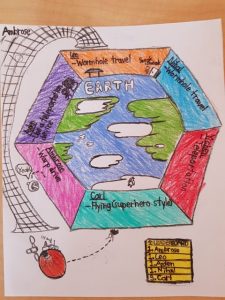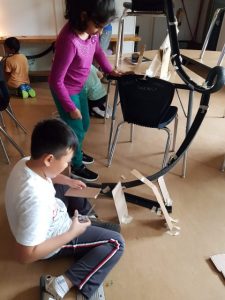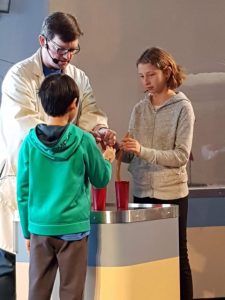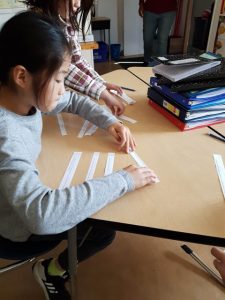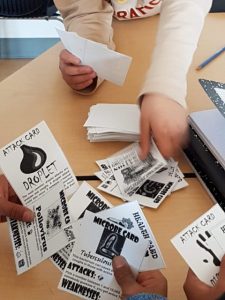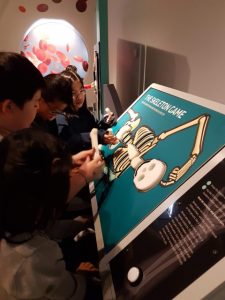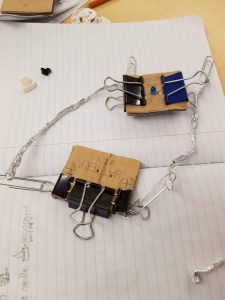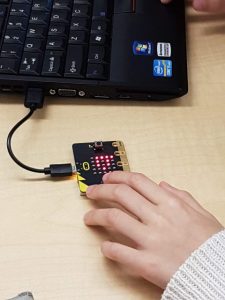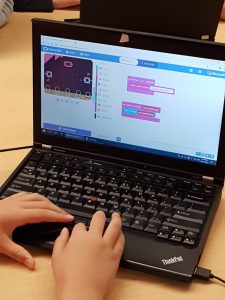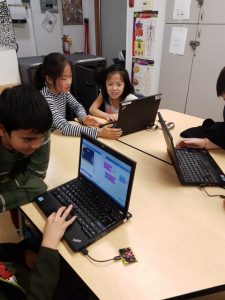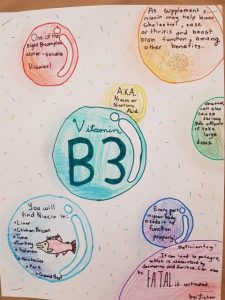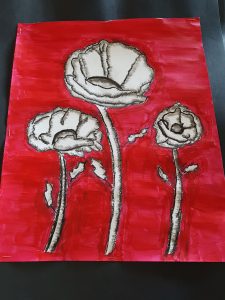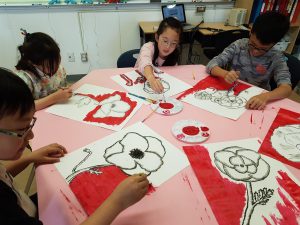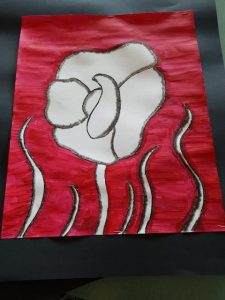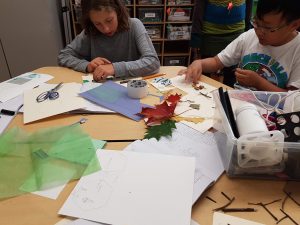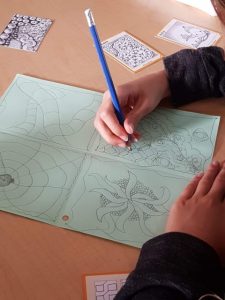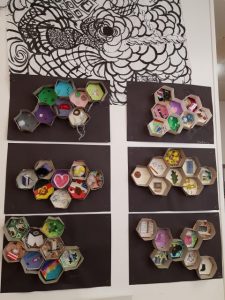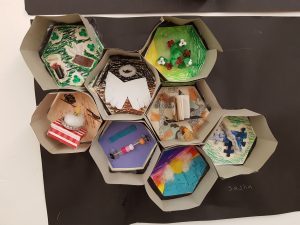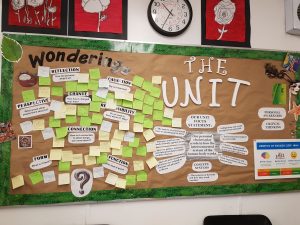Overview Term 1 Fall 2019 — Great Work Division 5!
Here is a review of the many things we did during term one!
To tie the big ideas from our curriculum together into a larger, enduring understanding,
we studied all subjects through the lens of a universal, conceptual theme.
For term one we focused on the concept of SYSTEMS
in our unit BODY WORKS.
Unit focus statement:
Our personal choices play a role
in how the interconnected system of the human body works.
SUNCREST CONNECTS! Let’s Make a Great Learning Community!
We spent the first two weeks creating the foundation of a great learning community! We created table map graphs to visually show how we are connected through common activities, interests, and preferences. We worked in small teams to design marble roller coasters all over the classroom, discussing both science concepts and what great collaboration looks like during projects. With the entire school community, we created a drumming performance, focusing on working as a team to make music.
To start our unit, we brainstormed what makes a classroom SYSTEM work well, relating it to the UNIVERSAL SYSTEMS MODEL, an important part of our unit discussions. What do we want to get out of our learning? (output) What do we need to put in to our learning experiences to accomplish our desired output? (input/process)
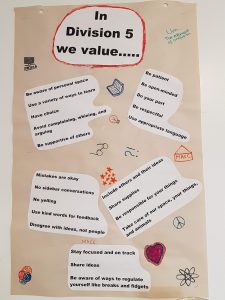 To better understand this, we analyzed other systems we know, such as our community and ecosystems. Then, we identified what our classroom needs to contribute to a successful system. Students made a poster of our essential agreements and values and posted it in the classroom.
To better understand this, we analyzed other systems we know, such as our community and ecosystems. Then, we identified what our classroom needs to contribute to a successful system. Students made a poster of our essential agreements and values and posted it in the classroom.
Throughout the term, we focused on the core competencies of personal awareness and critical thinking, which were embedded into each activity and lesson for the unit.
THE HUMAN BODY SYSTEMS! (Science, Socials and Inquiry Processes, LA)
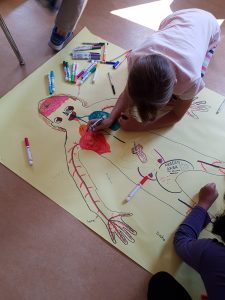 What do you already know about human anatomy? We created life-sized drawings of classmates to identify the inside parts we already knew from our many body systems. We already knew quite a bit, but we needed some more specific information.
What do you already know about human anatomy? We created life-sized drawings of classmates to identify the inside parts we already knew from our many body systems. We already knew quite a bit, but we needed some more specific information.
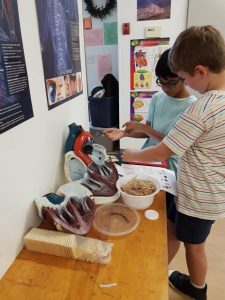 So, we did independent investigation stations! We gathered facts from non-fiction books and online resources like Kids Health, and completed fun experiments on lung capacity, heart rate, and digestive system length.
So, we did independent investigation stations! We gathered facts from non-fiction books and online resources like Kids Health, and completed fun experiments on lung capacity, heart rate, and digestive system length.
We then pretended the Human Body Corporation was having money problems, needed to make budget cuts, and planned to fire one of the many organs in the body! After learning about paragraphs and business letter format, each student chose an organ to research further and wrote a letter to the Corporation with detailed reasons their organ should not be fired!
Our Science World trip provided opportunities to see the Digestion Show and learn many facts, such as it takes 18-24 hours to fully digest food! We saw the IMAX movie Human Body, which provided detailed visuals on how the smallest parts of our body keep us alive each day.
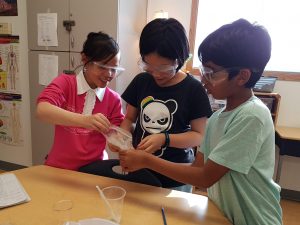 We did experiments to expand our knowledge of germs and how they are spread. Students learned to use the scientific method, to gather data through careful observations, and to analyze results using math and critical-thinking skills.
We did experiments to expand our knowledge of germs and how they are spread. Students learned to use the scientific method, to gather data through careful observations, and to analyze results using math and critical-thinking skills.
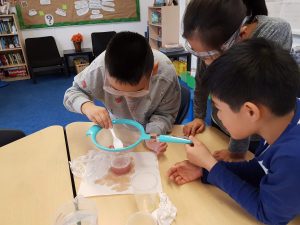 We discussed genetic traits and extracted strawberry DNA, a process which allowed us to learn the role soap plays in bursting the cell membranes of pathogens. Then, we had discussions about herd immunity, vaccines, epistemology (the diagnosis of diseases), and communicable and non-communicable diseases.
We discussed genetic traits and extracted strawberry DNA, a process which allowed us to learn the role soap plays in bursting the cell membranes of pathogens. Then, we had discussions about herd immunity, vaccines, epistemology (the diagnosis of diseases), and communicable and non-communicable diseases.
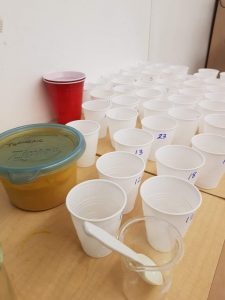 Our lab on “patient zero” allowed us to see how germs are spread quickly in a group! Finally, we tested 24 sites in the school and grew germ colonies in homemade petri dishes. We made careful observations, analyzed our data, and then concluded, based on the 24 sites, that there was a 65% chance or probability of having touched a bacteria, yeast, mold, or fungus. During all experiments, we used critical-thinking to ask questions and make conclusions, and we used personal awareness to work with others collaboratively and safely.
Our lab on “patient zero” allowed us to see how germs are spread quickly in a group! Finally, we tested 24 sites in the school and grew germ colonies in homemade petri dishes. We made careful observations, analyzed our data, and then concluded, based on the 24 sites, that there was a 65% chance or probability of having touched a bacteria, yeast, mold, or fungus. During all experiments, we used critical-thinking to ask questions and make conclusions, and we used personal awareness to work with others collaboratively and safely.
At the end of the unit, each student chose a disease to investigate further, with the purpose of learning how to take research notes and to find information that would help them diagnose some mystery diseases presented by Ms. D.
SYSTEMS and Applied Design Opportunities!
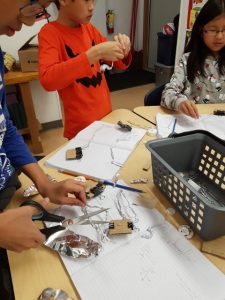 To connect with our unit, we looked at the SYSTEM of an electrical circuit. We discussed how electricity moves through a circuit, how a battery works, and how electrons and chemical reactions are involved. Then, using simple parts and cardboard, we created our own scrappy circuits! It involved trial and error, fine-motor skills, and critical thinking as we solved problems to make LEDs light up!
To connect with our unit, we looked at the SYSTEM of an electrical circuit. We discussed how electricity moves through a circuit, how a battery works, and how electrons and chemical reactions are involved. Then, using simple parts and cardboard, we created our own scrappy circuits! It involved trial and error, fine-motor skills, and critical thinking as we solved problems to make LEDs light up!
In October, we had a visit from KidsCoding, and we discussed artificial intelligence, coding, and how to use micro:bits.
We enjoyed making games and sending messages to one another via radio on our computers! Students had to use patience, communication skills, and critical thinking to create the right series of coding steps to instruct their devices.
Food Choices & The Body (Socials, Science, PHE, Career Education, LA):
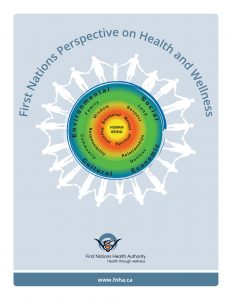 To make our SYSTEM of the human body function effectively, we need to be aware of the INPUTS we put into our body such as food. Students looked at informational graphs, watched TED talks, and listened to a variety of perspectives about good health to learn how to make positive food and environmental choices.
To make our SYSTEM of the human body function effectively, we need to be aware of the INPUTS we put into our body such as food. Students looked at informational graphs, watched TED talks, and listened to a variety of perspectives about good health to learn how to make positive food and environmental choices.
This included exploring the Indigenous Health and Wellness Model to discuss holistic aspects of health, such as the relationship between good health and your connection with family and community.
We explored mindful eating, which means having presence while eating and becoming aware of the eating experience. It involves savoring food, and through this, eating less, because you are fully enjoying what you eat. We practiced while eating fresh apple and plums, using descriptive language to record the experience.
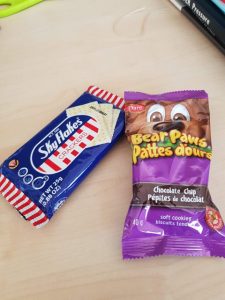 Students brought in snacks and analyzed ingredients lists and food labels to better understand the nutritional value of processed foods.
Students brought in snacks and analyzed ingredients lists and food labels to better understand the nutritional value of processed foods. 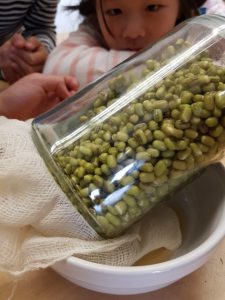
After this, they grew delicious sprouts, which we ate during the Halloween Party! We learned that soaking beans and allowing them to sprout before eating deactivates the enzyme inhibitors found around the bean. Sprouts have vitamin C and are digested more readily once the inhibitor is gone!
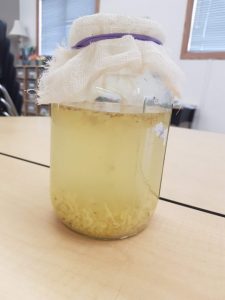 With inspiration from the book GUT: The Inside Story of Our Body’s Most Underrated Organ, we learned about probiotics and the healthy bacteria in our gut biome. We made homemade Ginger Ale so we could try creating our own healthy bacteria in a tasty drink!
With inspiration from the book GUT: The Inside Story of Our Body’s Most Underrated Organ, we learned about probiotics and the healthy bacteria in our gut biome. We made homemade Ginger Ale so we could try creating our own healthy bacteria in a tasty drink!
We also studied the impact of vitamins and minerals on the body. Each student chose and conducted research about a vitamin or mineral and its impact on the body. They then created informational posters with facts to share with their classmates.
Gathering and Communicating Data in Math:
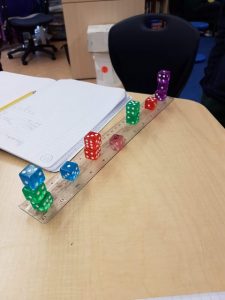 We played many probability games, read the entertaining book It’s Possible, discussed the language referring to probability, and through experiments discovered the difference between experimental and theoretical probability. This involved discussion of basic fractions, decimals, and how to find percentages. We applied this math to our germ lab to express the probability of touching pathogens in locations throughout the school. This is an example of how math knowledge can help us make personal choices that impact our health in positive ways.
We played many probability games, read the entertaining book It’s Possible, discussed the language referring to probability, and through experiments discovered the difference between experimental and theoretical probability. This involved discussion of basic fractions, decimals, and how to find percentages. We applied this math to our germ lab to express the probability of touching pathogens in locations throughout the school. This is an example of how math knowledge can help us make personal choices that impact our health in positive ways.
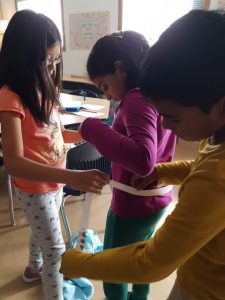 We explored imperial and metric SYSTEMS of measurement, then practiced using measurement tools and metric conversion to determine how much personal space we could tolerate or different distances on parts of the body.
We explored imperial and metric SYSTEMS of measurement, then practiced using measurement tools and metric conversion to determine how much personal space we could tolerate or different distances on parts of the body. 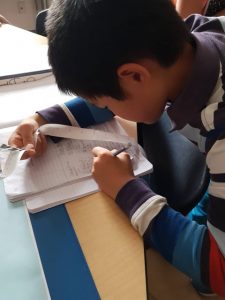
We used critical-thinking to think about how gathering data on measurements of the body could be used in creative ways by anthropologists or makers of clothing.
We used the NY Times Learning Network to look at different types of graphs about nutrition, climate change, and blood sugar levels. We practiced two questions to increase our critical thinking and observation skills, “What do you notice?” and “What do you wonder?” We identified essential parts of a graph and how graphs communicate data.
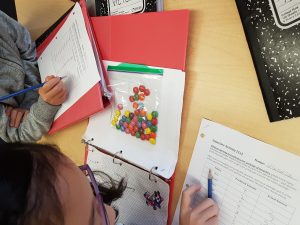 We practiced gathering data, whether about ourselves, genetic traits, or class preferences. We learned to analyze data using measures of central tendency such as mean, median, mode, and range, then applied these skills as we pretended to be consultants analyzing Skittles packages for a fair distribution of colours.
We practiced gathering data, whether about ourselves, genetic traits, or class preferences. We learned to analyze data using measures of central tendency such as mean, median, mode, and range, then applied these skills as we pretended to be consultants analyzing Skittles packages for a fair distribution of colours.
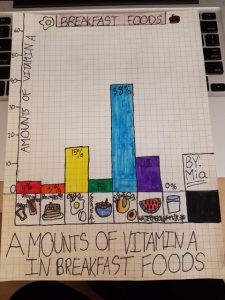
Students ended the unit creating a survey about nutrition in their peers snack foods, displaying the data in a graph, and analyzing the results for patterns.
Throughout our activities, students built skills in data management, used critical-thinking skills to present results, and became more aware of their food choices through a deeper understanding of the numbers on food packaging that tell us about nutrition.
Thank you to all of the students who helped with Family Math Games Night, teaching younger students games!
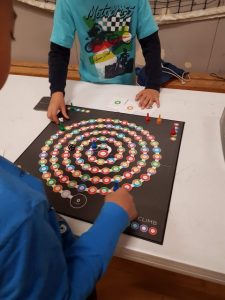
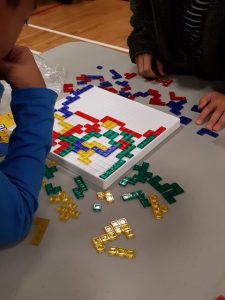
Mental Health & Self-Expression (Socials/Science/PHE/Career Ed/Art/LA):
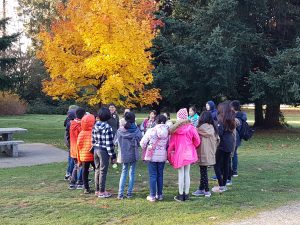 Students explored the connection between our mental health and physical health. We started by using the Mind Up Curriculum to look at brain structure, so we could understand how the brain responds to intense emotion.
Students explored the connection between our mental health and physical health. We started by using the Mind Up Curriculum to look at brain structure, so we could understand how the brain responds to intense emotion.
We learned the function of the main parts, including the amygdala, pre-frontal cortex, and hippocampus. Then, we created mini skits to show how the brain responds to moments of stress and emotion. We had great discussion about how it is hard to make rational decisions when one is emotional, so it is important to find self-regulation strategies to calm the brain before taking action.
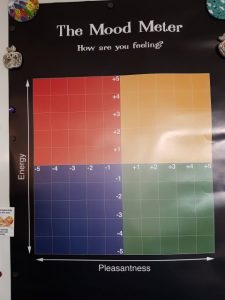 We tried many self-regulation strategies in class, including daily mindful breathing, outdoor breaks, practicing gratitude, taking mindful walks, journaling, using the RULER chart to be aware of your emotional state, and using the break board to take a moment during longer work periods.
We tried many self-regulation strategies in class, including daily mindful breathing, outdoor breaks, practicing gratitude, taking mindful walks, journaling, using the RULER chart to be aware of your emotional state, and using the break board to take a moment during longer work periods.
We watched the TED talk “How to Make Stress Your Friend” and discussed how not all stress is bad. We learned that managing stress and being connected with your community contributes to long life.
We also identified the different types of mental health conditions that exist, discussed the stigma involved with mental health issues, and brainstormed how to be understanding and supportive of anyone going through stress or difficulties in their life.
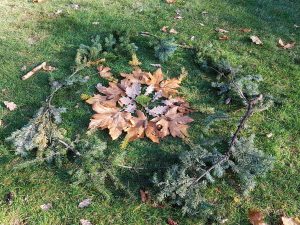 Spending time in the outdoors can help our mental health.
Spending time in the outdoors can help our mental health.
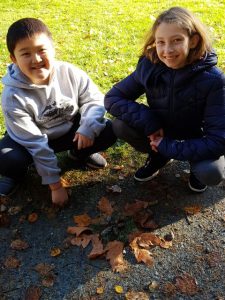 During a walking field trip to Central Park, we made mandalas with nature-found materials, did a nature scavenger hunt requiring close observation of our surroundings, and talked about having gratitude for nature, acknowledging our special connection to the land. Getting physical definitely helps our health, and we had fun doing many outdoor and indoor cooperative games for gym.
During a walking field trip to Central Park, we made mandalas with nature-found materials, did a nature scavenger hunt requiring close observation of our surroundings, and talked about having gratitude for nature, acknowledging our special connection to the land. Getting physical definitely helps our health, and we had fun doing many outdoor and indoor cooperative games for gym.
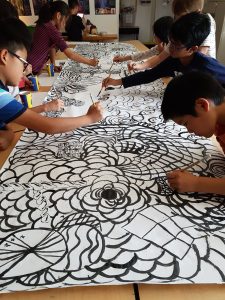
Creativity is an important tool for mental health. We practiced zentangle doodling related to mindfulness and created a large cooperative mural of zentangle designs.
We created beautiful poppy paintings for Remembrance Day, applying elements and principles of art such as colour, emphasis, and negative space.
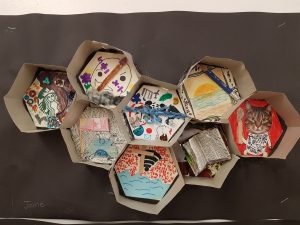 We also created HIVE art, using mixed media to represent people, places, and things that bring us strength
We also created HIVE art, using mixed media to represent people, places, and things that bring us strength
and help us thrive.
Language Arts & Empowering Someone Through a TED TALK!
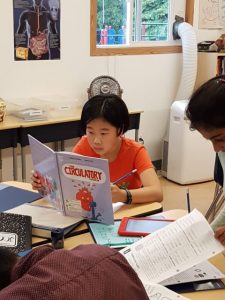 Throughout all subjects, we used language arts curricular competencies to analyze news articles and non-fiction resources, to communicate information in graphics and speeches, and to do research on diseases or nutrition. We read a variety of articles from Kids Health, learned to take research notes by identifying key ideas, identified criteria for finding appropriate resources online, and discussed ways to better present our ideas in clear, organized, and/or persuasive ways.
Throughout all subjects, we used language arts curricular competencies to analyze news articles and non-fiction resources, to communicate information in graphics and speeches, and to do research on diseases or nutrition. We read a variety of articles from Kids Health, learned to take research notes by identifying key ideas, identified criteria for finding appropriate resources online, and discussed ways to better present our ideas in clear, organized, and/or persuasive ways.
We learned about personal and business letter formats, and we discussed how to make a strong, organized paragraph. We strengthened our writing by adding creative vocabulary and looking for ways to express ideas in ways that inspire others. We talked about what makes an effective speech, and how to be a respectful active listener in the audience.
We also discussed how to ask more interesting questions using the inquiry wall prompts, and how to add detail to our e-portfolios to better communicate ideas and our learning.
Finally, after watching many TED talks this term, we created an inspiring TED Talk on a topic of choice, sharing personal examples and research to empower our audience.
French:
In connection with our learning about the human body, we learned phrases for basic body parts, question words, and numbers. For example, “This is my foot.” or “I have two legs.” We practiced French using songs, conversation with peers, and games of Simon Says. Students with French fluency read French articles and picture books, then wrote information about them in their journals.
Government & Climate Change:
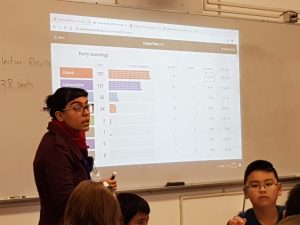 In connection with the October federal election and our discussions on SYSTEMS, we learned about levels of government and their responsibilities, the electoral system, and how the voting process works. We participated in Student Vote, adding our votes to the national Student Vote results. We also had a pretend election in class, with speakers from invented political parties.
In connection with the October federal election and our discussions on SYSTEMS, we learned about levels of government and their responsibilities, the electoral system, and how the voting process works. We participated in Student Vote, adding our votes to the national Student Vote results. We also had a pretend election in class, with speakers from invented political parties.
We discussed the impact of climate change and CO2 levels during Greta Thunberg’s visit to North America this fall. We also read and analyzed readings from the news about the Students Global Climate Action Strike.
Music:
Students had music with Ms. Fletcher 3 times per week. The Big Idea for term one was: Music is a unique language for creating and communicating. Students worked on developing music skills – beat, rhythm, tempo, pitch, dynamics and form through playing percussion instruments and xylophones, creating dances, and learning songs to present at the winter musical. We look forward to their performance on Dec. 18th!
Putting Learning Together in a Creative Way!
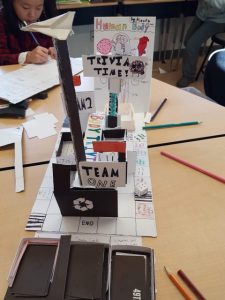 We ended the term synthesizing our knowledge of SYSTEMS and showing our understanding of how personal choices impact the human body through the creation of a fun game to play with peers.
We ended the term synthesizing our knowledge of SYSTEMS and showing our understanding of how personal choices impact the human body through the creation of a fun game to play with peers.
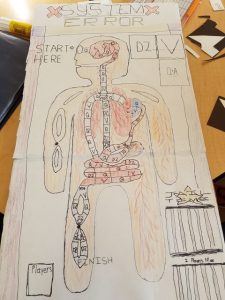 Students had a lot of fun using applied design skills to create unique and interactive games!
Students had a lot of fun using applied design skills to create unique and interactive games!
Overall, it was an amazing term. We thank Ms. Boroumand, our student teacher, for bringing her knowledge to Division 5 and helping us to learn so much about physical and mental health.
Students completed self-reflections, and we are looking forward to having our Learning Conferences to make goals for term two!

